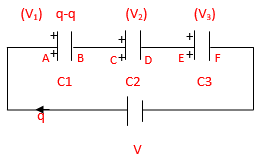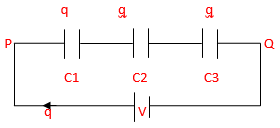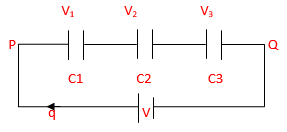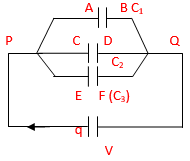Series Combination of Capacitors
Description:
Let there are three capavitors (C1, C2 and C3) having capacitance (C1, C2 and C3) are connected in series. Capacitor C1 consists of two plates ( say plate A and B), Capacitor C2 consists of two plates ( say plate C and D) whereas Capacitor C3 consists of two plates ( say plate E and F).
Plate B of C1 is connected with plate C of C2 whereas plate D of C2 is connected with plate E of C3. Plates A and F are connected to point P and Q. These points are connected to a battery. So, the potential difference (V) is developed at point P and Q. Points are As shown in figure.

As the battery is connected, the positive charges start flowing from positive terminal of battery to plate A. It flows till charge at plate A reaches to ‘q’. Now due to induction, plate (A) starts attracting equal number electrons from capacitor C2. This electrons collects over plate B there by making it negatively charged and hence charge attained by it is (-q). On the other hand, plate A repels the same number of positive charges towards plate C and it attains (+q) charges. Similarly, plates D and F acquire (-q) charge and plate E acquires (q) charge and finally same amount of charge is taken out of plate F towards the negative terminal of the battery. as shown in figure.

Features of series combination
Feature 1 − Same charge is acquired by all the capacitors connected in series.
From figure we can see that, in series as battery qives q amount of charge, the same (q) amount of charge is acquired by each capacitor. and finally same amount of charge is taken out to the negative terminal of the battery. This is how charges travels and are distributed.

Feature 2 − Potential is divided across all the capacitors.
The total work done per unit charge(q) gives the net potential. From circuit total work done by a unit charge to travel from P to Q be W.
V = w/q
let the work done by charge to cross each capacitor( C1, C2, C3) in series be W1, W2, W3 respectively.
So, W = W1 + W2 + W3
Dividing the equation by the same charge ‘q’, we get:
W/q = w1/q + w2/q + w3/q
V = V1 + V2 + V3
V1, V2 and V3 are the potential difference across capacitors C1, C2, C3 respectively. It means that the potential of the battery is divided into three parts across the three capacitors.

Feature 3 − In series combination capacitance decreases and the equivalent capacitance is always smaller than the smallest.
We know that in series,
V = V1 + V2 + V3
As the same charge ‘q’ is flowing through the circuit so, dividing the equation by q we get:
v/q = v1/q + v2/q + v3/q ------(1)
We know that, q = CV
C = q/v
OR 1/c = v/q
So, equation (1) becomes:
1/c = 1/c1 + 1/c2 + 1/c3
This gives the relation of capacitance of system with the capacitance C1, C2 and C3
If C is the total capacitance of the system, So, this can be called as equivalent capacitance (Cequivalent)
So, 1/Cequivalent = 1/c1 + 1/c2 + 1/c3

To check whether equivalent capacitance increases or decreases in series combination. Take a combination of two capacitor, each having capacitance of 2μf and are connected in series.
Using;
1/Cequivalent = 1/c1 + 1/c2
Putting the capacitance value of each capacitor we get:
1/Cequivalent = 1/2 + 1/2 = 1
So we conclude from above example that capacitance decreases in series combination and the equivalent capacitance is always smaller than the smallest.
Capacitance for ‘n’ number of capacitors
If there are ‘n’ number of capacitors in series and each having capacitance = Cμf then,
1/Cequivalent = 1/c + 1/c + 1/c + ... + 1/cn
Cequivalent = C/n

